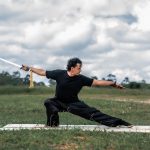In the high-stakes world of mixed martial arts (MMA) and Ultimate Fighting Championship (UFC), cardio reigns supreme. The ability to maintain peak performance and outlast opponents is a crucial factor in achieving victory. But not all cardio workouts are created equal.
In this article, we delve into the best cardio exercises for MMA and UFC fighters, exploring specific techniques that target essential skills and movements, as well as nonspecific workouts that enhance overall fitness and recovery.
By unlocking the secrets to optimal cardio training, fighters can gain a competitive edge in the octagon.
Key Takeaways
- Interval training is crucial for MMA/UFC fighters as it boosts cardiovascular fitness, simulates fight intensity, and improves endurance.
- Nonspecific cardio workouts like swimming and jumping rope are beneficial for overall fitness improvement and targeting different muscle groups.
- Bag and pad work is essential for developing striking skills, accuracy, timing, power, and endurance.
- Sparring plays a vital role in training by testing skills, improving timing and accuracy, and developing fight strategies against live opponents.
Specific Cardio Workouts for MMA/UFC Fighters
The specific cardio workouts for MMA/UFC fighters focus on improving their cardiovascular endurance and enhancing their fighting techniques and movement. One of the most effective methods is interval training, which involves alternating periods of high-intensity activity with periods of rest or low-intensity activity. This type of training not only boosts cardiovascular fitness but also simulates the intensity of a fight, allowing fighters to better adapt to the demands of the sport.
Additionally, incorporating rest and recovery into their training routine is crucial for MMA/UFC fighters. It allows the body to repair and rebuild, reducing the risk of injury and optimizing performance. Rest days and adequate sleep are just as important as the training itself, ensuring that fighters can perform at their best during intense bouts.
Benefits of Specific Cardio Workouts
Specific cardio workouts for MMA/UFC fighters offer a multitude of advantages. These workouts can improve cardiovascular endurance, enhance fighting techniques and movement, save energy during fights, train multiple aspects simultaneously, and develop fight-specific skills.
One of the key benefits of these workouts is the improvement in cardiovascular endurance. This is crucial for maintaining a high pace throughout a fight and preventing fatigue.
Additionally, these workouts help fighters enhance their fighting techniques and movement. By engaging in specific cardio exercises, fighters can improve their agility, footwork, and overall performance in the cage.
By training multiple aspects simultaneously, such as endurance, strength, and technique, fighters can efficiently use their time and maximize their training sessions.
Furthermore, these workouts promote the development of fight-specific skills. Fighters can practice striking combos, takedowns, and grappling techniques, which are essential for success in MMA/UFC bouts.
Nonspecific Cardio Workouts for MMA/UFC Fighters
Moving beyond specific cardio workouts, MMA/UFC fighters can also benefit from incorporating nonspecific cardio workouts into their training regimen. These workouts provide a variety of benefits, including restorative effects for the body, transferable improvements to fight-related skills, enhanced overall fitness, and a break from the monotony of specific training routines. Two excellent options for nonspecific cardio workouts are swimming and jumping rope.
Swimming is an ideal choice for endurance training, as it engages the entire body and builds cardiovascular stamina. It also offers a low-impact workout, reducing the risk of injury. Jumping rope, on the other hand, is a fantastic exercise for agility and footwork. It improves coordination, quickness, and timing, all of which are essential for MMA/UFC fighters.
To further illustrate the benefits of incorporating these workouts, refer to the table below:
| Workout | Benefits |
|---|---|
| Swimming | – Builds cardiovascular endurance |
| – Engages the entire body | |
| – Low-impact exercise | |
| Jumping Rope | – Enhances agility and footwork |
| – Improves coordination, quickness, and timing |
Advantages of Nonspecific Cardio Workouts
Incorporating nonspecific cardio workouts into the training regimen of MMA/UFC fighters offers a range of advantages. These workouts may not directly mimic the movements of a fight, but they provide benefits that can enhance overall performance.
Advantages of nonspecific cardio workouts:
- Transferability: Nonspecific cardio exercises, such as roadwork and cycling, improve cardiovascular endurance and stamina. This increased endurance can translate into better performance during fights, allowing fighters to maintain a high level of intensity for longer periods.
- Overall fitness: Nonspecific cardio workouts target different muscle groups, improving overall fitness and strength. They can also help prevent injury by strengthening the body as a whole, rather than focusing on specific fight-related skills.
- Variety in training routine: Incorporating different types of cardio workouts adds variety to the training routine, keeping it interesting and preventing boredom. This variety also challenges the body in different ways, promoting adaptation and growth.
Additional Related Posts
Continuing the exploration of relevant content, the article delves into other informative and related posts surrounding MMA/UFC fighters and their training. These additional posts provide valuable insights into various aspects of fighter preparation and recovery. Two notable posts include 'Why Do MMA/UFC Fighters Take Ice Baths? (6 Scientific Pros)' and '10 Best Sauna Benefits for Athletes and Martial Artists'. These articles delve into the benefits of ice baths and saunas for fighters, shedding light on their impact on performance and recovery. Incorporating a 3 column and 3 row table, we can compare the benefits of ice baths and saunas for MMA/UFC fighters:
| Ice Bath Benefits | Sauna Benefits | |
|---|---|---|
| 1 | Reduces inflammation and soreness | Enhances cardiovascular function |
| 2 | Accelerates muscle recovery | Detoxifies the body |
| 3 | Improves immune system | Increases mental toughness |
Bag and Pad Work
The training regimen for MMA/UFC fighters includes incorporating bag and pad work as a crucial component. Bag and pad technique allows fighters to develop their striking skills, improve accuracy and timing, and build power and endurance.
It also provides an opportunity to work on combinations and footwork, enhancing overall fighting abilities. When it comes to bag and pad drills, fighters can choose from a variety of options based on their specific needs and goals.
Some popular types of bag and pad drills include heavy bag work, speed bag drills, focus mitt training, and Thai pad drills. Each drill focuses on different aspects of striking, allowing fighters to refine their technique, increase their speed and power, and simulate real fight scenarios.
Incorporating bag and pad work into the training routine is essential for MMA/UFC fighters looking to excel in the striking aspect of their game.
Sparring
Sparring plays a vital role in the training regimen of MMA/UFC fighters, providing them with a dynamic and realistic environment to apply their striking and grappling techniques against live opponents. It is an essential component of their preparation, allowing fighters to test their skills, improve their timing and accuracy, and develop their fight strategies.
To optimize the benefits of sparring, fighters can incorporate various sparring techniques and strategies into their training sessions. For example, they can focus on specific aspects such as striking, grappling, or clinching, or they can engage in full-contact sparring to simulate real fight conditions. Additionally, fighters can combine their sparring sessions with cardio workouts to enhance their endurance and conditioning levels.
Here is a table highlighting some effective sparring techniques and the corresponding cardio workouts that can be combined with them:
| Sparring Technique | Combining Cardio Workout |
|---|---|
| Striking | High-intensity interval training (HIIT) |
| Grappling | Circuit training |
| Clinching | Tabata training |
| Full-contact sparring | Plyometric exercises |
| Technical sparring | Long-distance running |
Shadowboxing
As we delve into the training methods for MMA/UFC fighters, it is important to explore the benefits of shadowboxing, a crucial component that complements sparring and enhances fighters' technical prowess.
Shadowboxing benefits fighters in various ways:
- Technique refinement: Shadowboxing allows fighters to focus on their form, footwork, and striking techniques without the distraction of an opponent. This repetitive practice helps build muscle memory and improves overall technique.
- Cardiovascular conditioning: Shadowboxing is a high-intensity workout that elevates the heart rate, making it an excellent cardio exercise. It helps improve fighters' endurance, stamina, and ability to sustain intense rounds in the ring.
- Mental preparation: Shadowboxing provides an opportunity for fighters to visualize and mentally rehearse their strategies, combinations, and defensive maneuvers. It enhances their mental focus, concentration, and reaction time during fights.
To maximize the benefits of shadowboxing, fighters should incorporate techniques such as mixing up punch combinations, incorporating footwork drills, and practicing defensive maneuvers. This ensures a well-rounded training session that hones both their physical and mental skills.
Chain Wrestling
Chain wrestling is a fundamental component of MMA/UFC training that incorporates fluid transitions between various grappling techniques. It is a crucial skill for fighters looking to dominate their opponents on the ground. In chain wrestling, fighters seamlessly move from one technique to another, creating a relentless and unpredictable attack. This style of wrestling requires a high level of technique and skills training.
To excel in chain wrestling, fighters must develop a deep understanding of the different grappling techniques, such as takedowns, throws, submissions, and reversals. They must also hone their transitional skills, allowing them to smoothly flow from one move to another without giving their opponents a chance to counter. This requires hours of practice, drilling, and repetition.
Technique and skills training play a vital role in chain wrestling. Fighters must focus on perfecting their technique, ensuring that their moves are executed with precision and efficiency. They must also work on their timing, speed, and agility to seamlessly transition between techniques. By consistently refining their technique and skills, fighters can become masters of chain wrestling, gaining a significant advantage over their opponents in the cage.
Frequently Asked Questions
How Often Should Mma/Ufc Fighters Incorporate Specific Cardio Workouts Into Their Training Routine?
MMA/UFC fighters should incorporate specific cardio workouts into their training routine with a frequency that allows for optimal rest and recovery. Balancing intense sessions with adequate rest is crucial for maximizing performance and preventing overtraining.
Are There Any Specific Cardio Workouts That Are Particularly Effective for Improving Agility and Footwork in the Octagon?
Agility training and footwork drills are crucial for MMA/UFC fighters to excel in the octagon. Incorporating specific cardio workouts that focus on these aspects can greatly enhance an athlete's agility and footwork, leading to improved performance and strategic advantages during fights.
Can Nonspecific Cardio Workouts, Such as Swimming or Cycling, Be Substituted for Specific Cardio Workouts in an Mma/Ufc Training Program?
Nonspecific cardio workouts like swimming or cycling can be effective substitutes for specific cardio workouts in an MMA/UFC training program. Swimming can improve endurance and provide a full-body workout, while cycling can enhance cardiovascular fitness and reduce impact on joints.
What Are Some Tips for Preventing Injuries During Specific Cardio Workouts, Such as Bag and Pad Work or Sparring?
To prevent injuries during specific cardio workouts like bag and pad work or sparring, it is crucial to prioritize safety measures. Tips include proper warm-up and stretching, using protective gear, maintaining proper technique, and listening to your body's signals to avoid overexertion.
How Long Should a Typical Cardio Workout Session Last for Mma/Ufc Fighters?
A typical cardio workout session for beginners in MMA/UFC can range from 20-30 minutes, gradually increasing over time. Cardio training plays a crucial role in enhancing endurance, allowing fighters to sustain high-intensity efforts throughout their matches.
Conclusion
In conclusion, the best cardio exercises for MMA and UFC fighters include specific workouts like bag and pad work, sparring, and shadowboxing, which target the skills and movements required in the ring.
Additionally, nonspecific workouts like roadwork, swimming, and cycling offer restorative benefits and enhance overall fitness.
By incorporating both types of cardio into their training regimen, fighters can optimize their performance and success in the octagon.
So, whether it's honing specific skills or improving overall endurance, a well-rounded cardio routine is essential for MMA and UFC fighters.
- 15 Best Martial Arts Weapons (Fighting & Training) - October 14, 2024
- Is Fencing a Martial Art? (Yes, 4 Reasons Why) - October 14, 2024
- 7 Best Martial Arts for Self-defense Ranked (Highly Effective) - October 14, 2024










